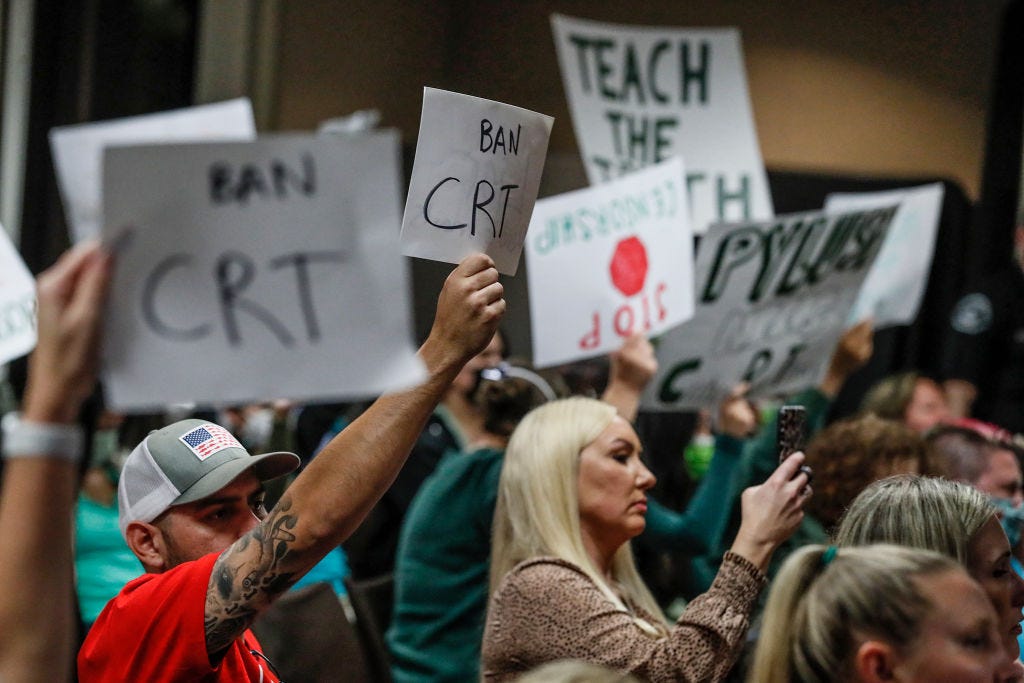Mainstream Media Outlets Keep Botching Their Coverage Of The Critical Race Theory Debate (Updated)
A lot of these laws are bad, but we need to have a shared, reality-based understanding of what's actually in them
This anti–critical race theory movement is getting out of control. Really out of control. To the point where, in Wisconsin, right-wing state legislators are seeking to ban an entire list of words from public school curricula. They literally don’t want kids to have the terms they need to accurately describe the unjust country they see around them!
That, at least, is the dark message you’d have received if you read Slate, Esquire, The Hill, or Scientific American this past fall. And it’s just plain incorrect — part of a growing problem mainstream outlets have with accurately conveying the actual, real-life content of the recent spate of bills attempting to “ban” “critical race theory” from schools.
You may have noticed those scare quotes. These bills are all over the place, and they often don’t actually come close to banning critical race theory per se. CRT is a big, loose academic movement that generally isn’t taught in K–12 schools (though that doesn’t mean “It isn’t taught in schools!” is close to an adequate political response, that it doesn’t pop up in teacher training materials, or that some folks within the education system aren’t trying to increase its presence in K–12 settings). Some of the bills outlaw schools from forcing students to endorse certain sentiments often associated with CRT (which is already illegal — schools can’t generally force students to endorse beliefs they don’t want to endorse), some of them try to regulate whether and how schools can differentiate between students on the basis of race, some do genuinely ban classroom discussion of subjects no right-thinking person should want banned, and others, well. . . . There are a lot of bills, many of them poorly written and conceptually confused. More on which in a bit.
But first: shouldn’t media outlets, at bare minimum, honestly and accurately tell the public what is and isn’t in these proposed laws?
Let’s start with what happened late last year. Here’s the relevant paragraph from the Scientific American article, which was authored by the academics Daniel Kreiss, Alice Marwick, and Francesca Bolla Tripodi, and which is headlined “The Anti–Critical Race Theory Movement Will Profoundly Affect Public Education”:
The perceived success of anti-CRT campaigns also jeopardizes any meaningful discussions of systemic inequality as part of public school education. As of August, eight states had passed anti-CRT legislation, and another 20 had introduced or planned bills. These bills have the practical effect of preventing even tacit acknowledgement of racism or sexism. A bill passed by the Wisconsin Assembly, for instance, bans any books, educational materials, or classroom discussions that include terms like “racial prejudice,” “patriarchy,” “structural inequality,” “intersectionality,” or, ironically, “critical self-reflection.” With this rule in place, it is hard to see how the Civil Rights Movement, women’s suffrage, or any number of events in American history could be discussed at all, let alone with depth. Indeed, such legislation may effectively “chill” the teaching of race by teachers scared to run afoul of conservative politics.
If you click on the words “bill passed,” you’ll see that the link points not to the bill itself, but to testimony about the bill given to the Wisconsin Legislature by its architect, Republican State Rep. Chuck Wichgers.
That testimony reads, in part:
I have an addendum to my testimony that lists several of the different terms associated with critical race theory or the words that are part of the praxis of the theory. Yes, it’s extensive and you can tell a lot of this was created in legal academia, but the point of this legislation is to prohibit it from being taught in our government schools.
. . . .
[From the addendum itself:] Additional terms and concepts below that either wholly violate the above clauses, or which may if taught through the framework of any of the prohibited activities defined above, partially violate the above clauses in what is otherwise broadly defined as “critical race theory”:
Then follows a long list of words, including the ones mentioned by the Scientific American article.
One thing you’ll notice is that Wichgers himself hedges, saying that the items on the list either violate the law or may do so “if taught” through a particular “framework.” He doesn’t specify which words land in which category, other than by pointing back to the text of the bill itself.
It’s quite easy to read that text, alongside the memo explaining what it does published by the nonpartisan Wisconsin Legislative Council. If you do so — a grand total of about seven pages of reading, mostly double-spaced — you’ll see that the actual text of the actual bill doesn’t really come close to banning any specific terms or concepts in the manner described by Scientific American and so many other outlets. It is not, in fact, “hard to see how the Civil Rights Movement, women’s suffrage, or any number of events in American history could be discussed at all” if the bill passed — not if you read it.
Keep reading with a 7-day free trial
Subscribe to Singal-Minded to keep reading this post and get 7 days of free access to the full post archives.


